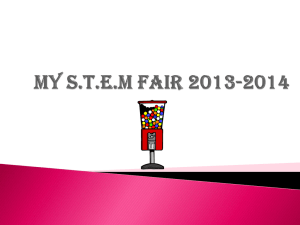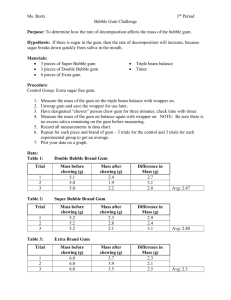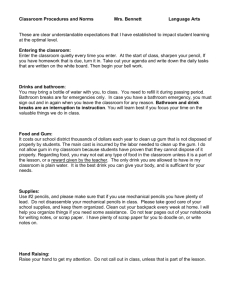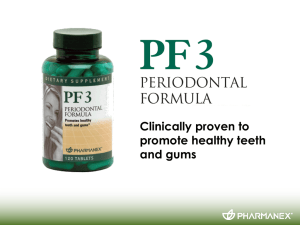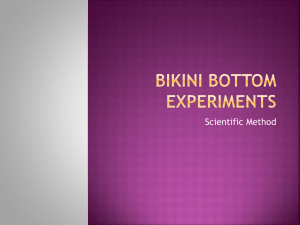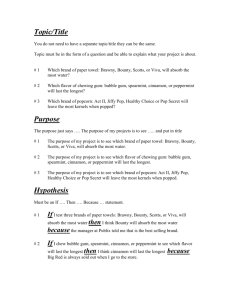Scientific Method Bubble Gum Lab
advertisement
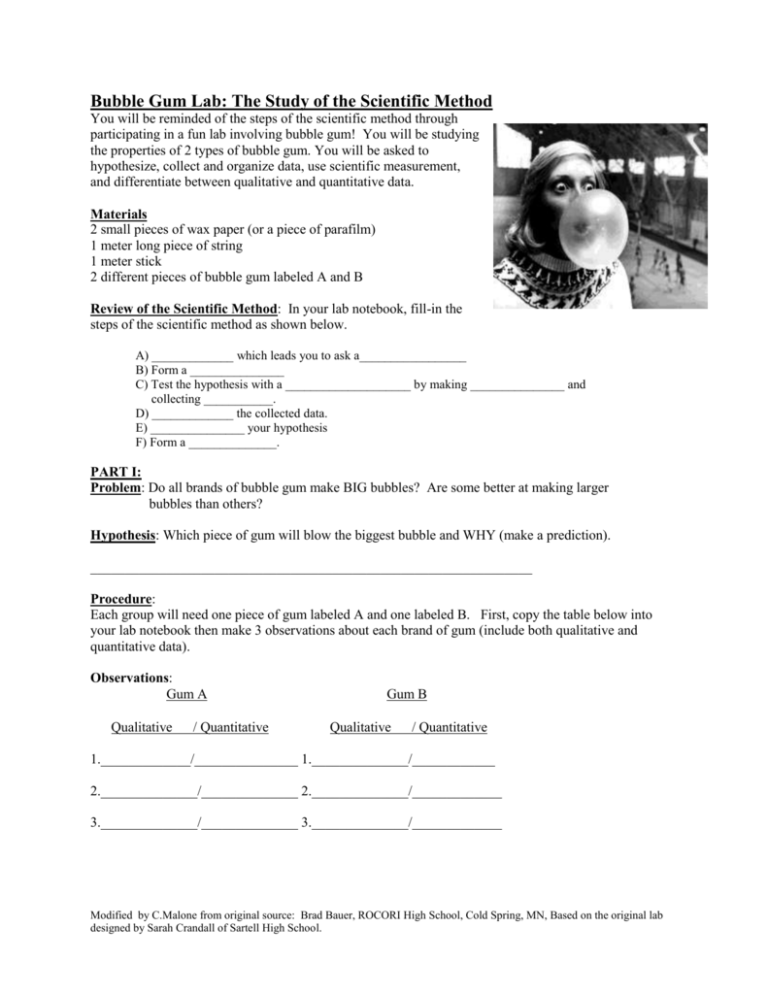
Bubble Gum Lab: The Study of the Scientific Method You will be reminded of the steps of the scientific method through participating in a fun lab involving bubble gum! You will be studying the properties of 2 types of bubble gum. You will be asked to hypothesize, collect and organize data, use scientific measurement, and differentiate between qualitative and quantitative data. Materials 2 small pieces of wax paper (or a piece of parafilm) 1 meter long piece of string 1 meter stick 2 different pieces of bubble gum labeled A and B Review of the Scientific Method: In your lab notebook, fill-in the steps of the scientific method as shown below. A) _____________ which leads you to ask a_________________ B) Form a _______________ C) Test the hypothesis with a ____________________ by making _______________ and collecting ___________. D) _____________ the collected data. E) _______________ your hypothesis F) Form a ______________. PART I: Problem: Do all brands of bubble gum make BIG bubbles? Are some better at making larger bubbles than others? Hypothesis: Which piece of gum will blow the biggest bubble and WHY (make a prediction). ________________________________________________________________ Procedure: Each group will need one piece of gum labeled A and one labeled B. First, copy the table below into your lab notebook then make 3 observations about each brand of gum (include both qualitative and quantitative data). Observations: Gum A Qualitative / Quantitative Gum B Qualitative / Quantitative 1._____________/_______________ 1.______________/____________ 2.______________/______________ 2.______________/_____________ 3.______________/______________ 3.______________/_____________ Modified by C.Malone from original source: Brad Bauer, ROCORI High School, Cold Spring, MN, Based on the original lab designed by Sarah Crandall of Sartell High School. Procedure: 1. The person with brand A will chew their piece of gum for 3 minutes. The person with brand B does not begin chewing until all the tests on brand A are completed. 2. Blow a bubble. 3. Using a string, your partner will measure the diameter (distance across) the bubble. Put the string on the meter stick to measure the distance in centimeters (cm). 4. Record the measurement in data table 1. Repeat the process for trials 2 and 3. 5. Find the average bubble size for brand A (add all the distances up and divide by 3) and put in the data table 1. 6. Repeat steps 1-5 with the brand B gum. 7. Fill-in your averages on the white board and copy the class data into data table 2. (don’t forget to get the class average!) 8. Graph the class average for brand A and B. Results: Data Table 1: Using a ruler, design a data table for your group’s data.(don’t forget a title/units) Data Table 2: Using a ruler, design a data table for the class data.(don’t forget a title/units) Graph 1: Comparison of Bubble Size: Bubble Gum A to Bubble Gum B (Use the graph paper in your lab notebook to graph the class averages. What goes on the x-axis, y-axis?; Will this be a line or bar graph?) PART 2: Combine with another group to complete this part of the lab. Problem: How does gum stretch-ability relate to bubble size? Hypothesis: Which brand of bubble gum (A or B) will be more stretchable? ______________________________________________________________________________ Procedure: 1. Each person with brand A will roll their gum into a ball (take turns- only one person at a time). 2. Hold the gum (brand A) by using the piece of wax paper (or parafilm). Another person in the group will hold the same piece of gum with another piece of wax paper. Hold the gum near your chest, begin to slowly walk backwards. 3. Another person in the group should hold the meter stick and measure the distance in centimeters the gum stretched before breaking. 4. Record the measurement in the data table#3. ONLY DO ONE TRIAL PER PERSON- Why? 5. Take the average of the two distances for brand A and record it in your group data table (table #3) 6. Repeat #1-5 for the brand B gum 7. Fill-in your averages on the white board and copy the class data into data table 4. (don’t forget to get the class average!) 8. Graph the class average for brand A and B (Graph#2). Data Table 3: Using a ruler, design a data table for your group’s data.(don’t forget a title/units) Data Table 4: Using a ruler, design a data table for the class data.(don’t forget a title/units) Graph 2: Comparison of Gum Stretch-ability: Bubble Gum A to Bubble Gum B (Use the graph paper in your lab notebook to graph the class averages. What goes on the x-axis, y-axis?; Will this be a line or bar graph?) Modified by C.Malone from original source: Brad Bauer, ROCORI High School, Cold Spring, MN, Based on the original lab designed by Sarah Crandall of Sartell High School. Conclusion: 1. Analyze Graph 1: Was there a difference in the bubble size between the two brands of gum? Which brand of gum is the best at blowing BIG bubbles? EXPLAIN (Support your answer with your data) 2. Analyze Graph 2: Was there a difference in the stretch-ability between the two brands of gum? Which brand of gum was the most stretchable? EXPLAIN (Support your answer with your data) 3. Analyze Graph 1 & 2: Was there a correlation between bubble size and stretch-ability of the two brands? EXPLAIN (Support your answer with your data) 4. How is qualitative data different from quantitative data? 5. Were SI (International System of Units) units used in this lab? Explain. 6. What is a controlled experiment? 7. What is an independent variable? Where is it plotted on a graph? What was this variable in our experiment? 8. What is a dependent variable? Where is it plotted on a graph? What was this variable in our experiment? 9. With your lab partner, list 5 variables that may affect/ or did affect the outcome of this experiment. 10. How would you improve this lab? (Name some procedural steps/controls/etc. that you would use to make this a more stringent lab) Conclusion: 1. Analyze Graph 1: Was there a difference in the bubble size between the two brands of gum? Which brand of gum is the best at blowing BIG bubbles? EXPLAIN (Support your answer with your data) 2. Analyze Graph 2: Was there a difference in the stretch-ability between the two brands of gum? Which brand of gum was the most stretchable? EXPLAIN (Support your answer with your data) 3. Analyze Graph 1 & 2: Was there a correlation between bubble size and stretch-ability of the two brands? EXPLAIN (Support your answer with your data) 4. How is qualitative data different from quantitative data? 5. Were SI (International System of Units) units used in this lab? Explain. 6. What is a controlled experiment? 7. What is an independent variable? Where is it plotted on a graph? What was this variable in our experiment? 8. What is a dependent variable? Where is it plotted on a graph? What was this variable in our experiment? 9. With your lab partner, list 5 variables that may affect/ or did affect the outcome of this experiment. 10. How would you improve this lab? (Name some procedural steps/controls/etc. that you would use to make this a more stringent lab) Modified by C.Malone from original source: Brad Bauer, ROCORI High School, Cold Spring, MN, Based on the original lab designed by Sarah Crandall of Sartell High School.

